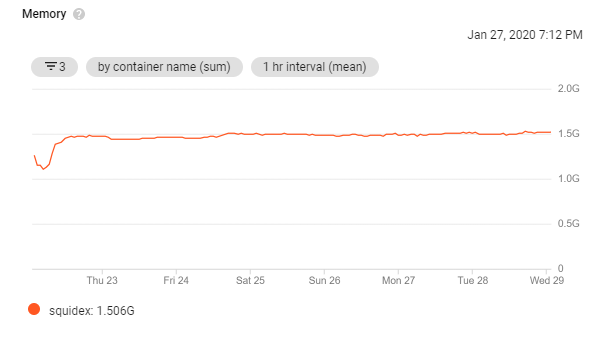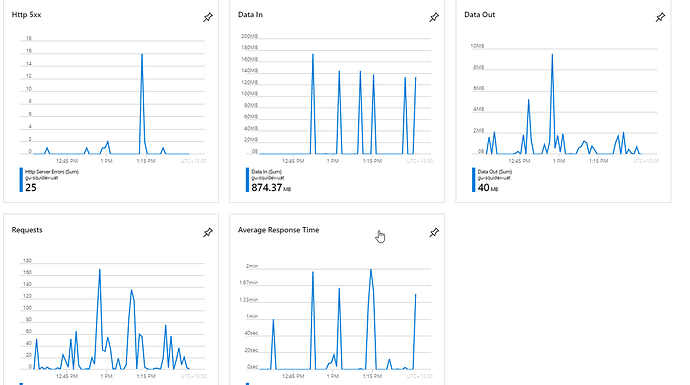I’m submitting a…
- [ ] Regression (a behavior that stopped working in a new release)
- [X] Bug report
- [ ] Performance issue
- [ ] Documentation issue or request
Current behavior
Users are adding content & assets and randomly getting errors when clicking Save. Average response time is going up from <1 second to up to 5 minutes. Already increased server specs from 1.75GB to 7GB as we saw high memory usage before; don’t see high memory usage anymore.
In the logs, seeing:
{
"logLevel": "Error",
"message": "Connection id \u00220HLT0GC5RTGV4\u0022, Request id \u00220HLT0GC5RTGV4:00000001\u0022: An unhandled exception was thrown by the application.",
"eventId": {
"id": 13,
"name": "ApplicationError"
},
"connectionId": "0HLT0GC5RTGV4",
"traceIdentifier": "0HLT0GC5RTGV4:00000001",
"exception": {
"type": "System.TimeoutException",
"message": "Response did not arrive on time in 00:00:30 for message: NewPlacement Request S172.16.1.3:11111:317534875*cli/2c0d4583@9e3161a8-\u003ES172.16.1.3:11111:317534875*grn/54B2229A/b1d1b18c@d8408ebc #1797878: . Target History is: \u003CS172.16.1.3:11111:317534875:*grn/54B2229A/b1d1b18c:@d8408ebc\u003E.",
"stackTrace": " at Orleans.Internal.OrleansTaskExtentions.\u003CToTypedTask\u003Eg__ConvertAsync|4_0[T](Task\u00601 asyncTask)\n at Squidex.Infrastructure.Commands.GrainCommandMiddleware\u00602.ExecuteCommandAsync(TCommand typedCommand) in /src/src/Squidex.Infrastructure/Commands/GrainCommandMiddleware.cs:line 49\n at Squidex.Infrastructure.Commands.GrainCommandMiddleware\u00602.ExecuteCommandAsync(CommandContext context) in /src/src/Squidex.Infrastructure/Commands/GrainCommandMiddleware.cs:line 40\n at Squidex.Infrastructure.Commands.GrainCommandMiddleware\u00602.HandleAsync(CommandContext context, Func\u00601 next) in /src/src/Squidex.Infrastructure/Commands/GrainCommandMiddleware.cs:line 30\n at Squidex.Domain.Apps.Entities.Contents.ContentCommandMiddleware.HandleAsync(CommandContext context, Func\u00601 next) in /src/src/Squidex.Domain.Apps.Entities/Contents/ContentCommandMiddleware.cs:line 42\n at Squidex.Infrastructure.Commands.GrainCommandMiddleware\u00602.HandleAsync(CommandContext context, Func\u00601 next) in /src/src/Squidex.Infrastructure/Commands/GrainCommandMiddleware.cs:line 30\n at Squidex.Domain.Apps.Entities.Assets.AssetCommandMiddleware.HandleCoreAsync(CommandContext context, Func\u00601 next) in /src/src/Squidex.Domain.Apps.Entities/Assets/AssetCommandMiddleware.cs:line 140\n at Squidex.Domain.Apps.Entities.Assets.AssetCommandMiddleware.HandleAsync(CommandContext context, Func\u00601 next) in /src/src/Squidex.Domain.Apps.Entities/Assets/AssetCommandMiddleware.cs:line 125\n at Squidex.Domain.Apps.Entities.Apps.AppCommandMiddleware.HandleAsync(CommandContext context, Func\u00601 next) in /src/src/Squidex.Domain.Apps.Entities/Apps/AppCommandMiddleware.cs:line 56\n at Squidex.Domain.Apps.Entities.Schemas.Indexes.SchemasIndex.HandleAsync(CommandContext context, Func\u00601 next) in /src/src/Squidex.Domain.Apps.Entities/Schemas/Indexes/SchemasIndex.cs:line 136\n at Squidex.Domain.Apps.Entities.Rules.Indexes.RulesIndex.HandleAsync(CommandContext context, Func\u00601 next) in /src/src/Squidex.Domain.Apps.Entities/Rules/Indexes/RulesIndex.cs:line 89\n at Squidex.Domain.Apps.Entities.Apps.Indexes.AppsIndex.HandleAsync(CommandContext context, Func\u00601 next) in /src/src/Squidex.Domain.Apps.Entities/Apps/Indexes/AppsIndex.cs:line 221\n at Squidex.Domain.Apps.Entities.Apps.Invitation.InviteUserCommandMiddleware.HandleAsync(CommandContext context, Func\u00601 next) in /src/src/Squidex.Domain.Apps.Entities/Apps/Invitation/InviteUserCommandMiddleware.cs:line 45\n at Squidex.Infrastructure.Commands.CustomCommandMiddlewareRunner.HandleAsync(CommandContext context, Func\u00601 next) in /src/src/Squidex.Infrastructure/Commands/CustomCommandMiddlewareRunner.cs:line 33\n at Squidex.Web.CommandMiddlewares.EnrichWithSchemaIdCommandMiddleware.HandleAsync(CommandContext context, Func\u00601 next) in /src/src/Squidex.Web/CommandMiddlewares/EnrichWithSchemaIdCommandMiddleware.cs:line 55\n at Squidex.Web.CommandMiddlewares.ETagCommandMiddleware.HandleAsync(CommandContext context, Func\u00601 next) in /src/src/Squidex.Web/CommandMiddlewares/ETagCommandMiddleware.cs:line 63\n at Squidex.Infrastructure.Commands.InMemoryCommandBus.PublishAsync(ICommand command) in /src/src/Squidex.Infrastructure/Commands/InMemoryCommandBus.cs:line 42\n at Squidex.Areas.Api.Controllers.Contents.ContentsController.InvokeCommandAsync(ICommand command) in /src/src/Squidex/Areas/Api/Controllers/Contents/ContentsController.cs:line 450\n at Squidex.Areas.Api.Controllers.Contents.ContentsController.PostContent(String app, String name, NamedContentData request, Boolean publish) in /src/src/Squidex/Areas/Api/Controllers/Contents/ContentsController.cs:line 287\n at Microsoft.AspNetCore.Mvc.Infrastructure.ActionMethodExecutor.TaskOfIActionResultExecutor.Execute(IActionResultTypeMapper mapper, ObjectMethodExecutor executor, Object controller, Object[] arguments)\n at Microsoft.AspNetCore.Mvc.Infrastructure.ControllerActionInvoker.\u003CInvokeActionMethodAsync\u003Eg__Logged|12_1(ControllerActionInvoker invoker)\n at Microsoft.AspNetCore.Mvc.Infrastructure.ControllerActionInvoker.\u003CInvokeNextActionFilterAsync\u003Eg__Awaited|10_0(ControllerActionInvoker invoker, Task lastTask, State next, Scope scope, Object state, Boolean isCompleted)\n at Microsoft.AspNetCore.Mvc.Infrastructure.ControllerActionInvoker.Rethrow(ActionExecutedContextSealed context)\n at Microsoft.AspNetCore.Mvc.Infrastructure.ControllerActionInvoker.Next(State\u0026 next, Scope\u0026 scope, Object\u0026 state, Boolean\u0026 isCompleted)\n at Microsoft.AspNetCore.Mvc.Infrastructure.ControllerActionInvoker.\u003CInvokeInnerFilterAsync\u003Eg__Awaited|13_0(ControllerActionInvoker invoker, Task lastTask, State next, Scope scope, Object state, Boolean isCompleted)\n at Microsoft.AspNetCore.Mvc.Infrastructure.ResourceInvoker.\u003CInvokeNextExceptionFilterAsync\u003Eg__Awaited|25_0(ResourceInvoker invoker, Task lastTask, State next, Scope scope, Object state, Boolean isCompleted)\n at Microsoft.AspNetCore.Mvc.Infrastructure.ResourceInvoker.Rethrow(ExceptionContextSealed context)\n at Microsoft.AspNetCore.Mvc.Infrastructure.ResourceInvoker.Next(State\u0026 next, Scope\u0026 scope, Object\u0026 state, Boolean\u0026 isCompleted)\n at Microsoft.AspNetCore.Mvc.Infrastructure.ResourceInvoker.\u003CInvokeNextResourceFilter\u003Eg__Awaited|24_0(ResourceInvoker invoker, Task lastTask, State next, Scope scope, Object state, Boolean isCompleted)\n at Microsoft.AspNetCore.Mvc.Infrastructure.ResourceInvoker.Rethrow(ResourceExecutedContextSealed context)\n at Microsoft.AspNetCore.Mvc.Infrastructure.ResourceInvoker.Next(State\u0026 next, Scope\u0026 scope, Object\u0026 state, Boolean\u0026 isCompleted)\n at Microsoft.AspNetCore.Mvc.Infrastructure.ResourceInvoker.\u003CInvokeFilterPipelineAsync\u003Eg__Awaited|19_0(ResourceInvoker invoker, Task lastTask, State next, Scope scope, Object state, Boolean isCompleted)\n at Microsoft.AspNetCore.Mvc.Infrastructure.ResourceInvoker.\u003CInvokeAsync\u003Eg__Logged|17_1(ResourceInvoker invoker)\n at Microsoft.AspNetCore.Routing.EndpointMiddleware.\u003CInvoke\u003Eg__AwaitRequestTask|6_0(Endpoint endpoint, Task requestTask, ILogger logger)\n at NSwag.AspNetCore.Middlewares.OpenApiDocumentMiddleware.Invoke(HttpContext context)\n at Microsoft.AspNetCore.Authorization.AuthorizationMiddleware.Invoke(HttpContext context)\n at Microsoft.AspNetCore.Authentication.AuthenticationMiddleware.Invoke(HttpContext context)\n at Microsoft.AspNetCore.Builder.Extensions.MapMiddleware.Invoke(HttpContext context)\n at Squidex.Web.Pipeline.EnforceHttpsMiddleware.InvokeAsync(HttpContext context, RequestDelegate next) in /src/src/Squidex.Web/Pipeline/EnforceHttpsMiddleware.cs:line 45\n at Microsoft.AspNetCore.Builder.UseMiddlewareExtensions.\u003C\u003Ec__DisplayClass5_1.\u003C\u003CUseMiddlewareInterface\u003Eb__1\u003Ed.MoveNext()\n--- End of stack trace from previous location where exception was thrown ---\n at Squidex.Web.Pipeline.LocalCacheMiddleware.InvokeAsync(HttpContext context, RequestDelegate next) in /src/src/Squidex.Web/Pipeline/LocalCacheMiddleware.cs:line 32\n at Microsoft.AspNetCore.Builder.UseMiddlewareExtensions.\u003C\u003Ec__DisplayClass5_1.\u003C\u003CUseMiddlewareInterface\u003Eb__1\u003Ed.MoveNext()\n--- End of stack trace from previous location where exception was thrown ---\n at Squidex.Web.Pipeline.RequestLogPerformanceMiddleware.InvokeAsync(HttpContext context, RequestDelegate next) in /src/src/Squidex.Web/Pipeline/RequestLogPerformanceMiddleware.cs:line 48\n at Microsoft.AspNetCore.Builder.UseMiddlewareExtensions.\u003C\u003Ec__DisplayClass5_1.\u003C\u003CUseMiddlewareInterface\u003Eb__1\u003Ed.MoveNext()\n--- End of stack trace from previous location where exception was thrown ---\n at Microsoft.AspNetCore.Builder.Extensions.MapMiddleware.Invoke(HttpContext context)\n at Microsoft.AspNetCore.Builder.Extensions.MapWhenMiddleware.Invoke(HttpContext context)\n at Microsoft.AspNetCore.Builder.Extensions.MapWhenMiddleware.Invoke(HttpContext context)\n at Microsoft.AspNetCore.Builder.Extensions.MapWhenMiddleware.Invoke(HttpContext context)\n at Microsoft.AspNetCore.Server.Kestrel.Core.Internal.Http.HttpProtocol.ProcessRequests[TContext](IHttpApplication\u00601 application)"
},
"app": {
"name": "Squidex",
"version": "1.0.0.0",
"sessionId": "15a06d39-9195-498e-b55a-1096fbe19065"
},
"web": {
"requestId": "4af47825-680f-4b0d-bc4c-f470d03ffdf3",
"requestPath": "/api/content/gearup-uat/winwire",
"requestMethod": "POST"
},
"timestamp": "Z",
"category": "Microsoft.AspNetCore.Server.Kestrel"
}
Expected behavior
The users can edit content without problems.
Environment
- [X] Self hosted with docker
- [ ] Self hosted with IIS
- [ ] Self hosted with other version
- [ ] Cloud version
Others:
Hosted on Azure. Mongo hosted on a separate VM. Currently using P2v2 for the single App Service Plan, so only one node.
I also noticed that once in a while memory usage drops to 0%, but not always when the problem occurs.



